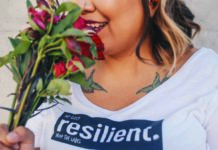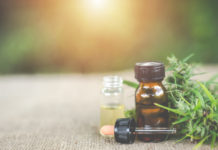
Understanding your hair and scalp type will help you customize a natural routine to keep your hair healthy and shiny.
Many of us feel that our hair is a key part of our identity—or at the very least, a key part of our appearance. Unfortunately, when it comes to how to best take care of our hair, a lot of myths and misconceptions abound. Here, we provide the lowdown on best taking care of your hair —naturally.
What is hair?
Each strand of hair is essentially a fibre made of a substance called keratin. The keratin is packed very tightly together and has an outer layer protecting it, called a cuticle. In order for our hair to stay healthy, the cuticle must stay intact. If the hair fibres are exposed (due to damage from any number of sources), frizzy or dull-looking hair results.
Scalp and hair types
Understanding your scalp and hair types will help you customize a routine to best care for your hair.
Scalp types
- Oily-looking hair is caused by an oily scalp. Excessive male sex hormones may be at play. Generally, it helps to wash the scalp every day.
- Dry skin can be prone to flakiness and even dandruff. While dry hair doesn’t need to be shampooed every day, if you’re prone to dandruff, it should be.
- Allergic/sensitive scalps can be dry, itchy, and irritated. You can benefit from doing a patch test before trying out any new product. Choose gentle, fragrance-free products.
Hair types
Learning the difference between texture and density will make it all become clear if you’ve ever been told you have fine, thick hair (which first appears to be an oxymoron).
- Fine, medium, or coarse refers to each hair’s texture, which is determined by its individual circumference. Coarse hair is larger, but also has a more porous cuticle.
- Thick or thin refers to the density of the hair overall—how many hairs are on the head. Generally, those with blond hair have the thickest hair, while redheads have the thinnest hair.
First things first: cleansing
Shampoo, rinse, repeat. That’s it, right? Well, it’s actually a bit more complicated.
The how-to
If your hair is prone to oiliness, it can be washed once a day; other than that, there’s no need to wash so often. Many of us wash too often, leading to dry and possibly damaged hair. In fact, some people who are very prone to dry skin likely only need to shampoo once a week or less.
Massage the shampoo into your scalp, trying not to get too much on the ends (which can be dry). And as far as the infamous “repeat” instruction—there’s no need for that either.
Choosing products
A common shampoo component to avoid is a foaming agent in the form of either sodium laureth sulphate (SLES) or sodium lauryl sulphate (SLS). We don’t need these lathering ingredients to ensure clean hair. SLS is known to be toxic to aquatic organisms, while SLES can be contaminated with carcinogens. Another harmful ingredient in shampoo is diethanolamine, or DEA. The concern here is that it is irritating and can react to form cancer-causing compounds.
Natural brands found at health food stores are safer options. If you have a particular concern, such as dandruff or chemically coloured hair, you’ll find a natural shampoo for that as well.
Don’t forget to condition
Is conditioning really necessary? In a word, yes. Just like we use a moisturizer on our faces after cleansing, conditioner is necessary to return important moisture to hair. It also increases shine, helps strengthen damaged hair, and can even boost resilience against harmful UV rays.
The how-to
Unlike shampoo, conditioner should be concentrated on the tips of hair, rather than the scalp. Condition each time you shampoo.
Choosing products
While not unique to conditioner, fragrance and parabens are two common ingredients to steer clear of. “Fragrance” can refer to a secret mixture of any number of potentially hazardous chemicals, while parabens are preservatives that act as hormone disruptors. Check out nontoxic conditioners at your favourite health food store.
Last but not least: styling
Easy does it!
Heat styling can be very harsh on our hair. To minimize damage, use as infrequently as possible, use at the tool’s lowest setting, and try not to touch the hot tool on your hair (for example, a straightening iron is more damaging than a blow-dryer, as it directly touches hair).
Some styling tricks recommended by the pros:
- Add the illusion of volume to the hair by switching up your part.
- Blow-dry upside down for fuller hair.
- Keep those curls away from brushes! Curly hair is more prone to breakage, so just a gentle post-shower combing is best.
Choosing products
In addition to avoiding the previously mentioned chemicals, petrolatum and siloxanes are two chemicals that are often added to hair care products to boost shine, soften, and act as a barrier. But petrolatum can be contaminated with chemicals associated with cancer and cause allergies, while toxic siloxanes can accumulate in our bodies over time and persist in the environment.
Again, healthier options can be found at natural health retailers.
Tools of the trade
- Wide-tooth comb: Always use a wide-tooth comb to remove tangles after washing.
- Hairbrush: Never brush your hair when it’s wet, as you’ll run the risk of damage and split ends. Contrary to popular belief, boar bristle brushes aren’t necessarily the best for your hair, because they can put a lot of friction on the hair cuticle.
- Hair ties: This should go without saying, but don’t use uncovered rubber bands.
- Styling tools: Whether you use a straightening iron, blow-dryer, or curling iron, use heat styling tools as little as possible for the healthiest hair. (Check out “styling” section for more info.)
- Swim cap: Although not normally thought of as a hair tool, swim caps are crucial for keeping hair protected from harsh chlorine when swimming in pools.
Hair myths & facts
Certain hairstyles can be damaging.
True. Wearing your hair back in a tight hairstyle (such as bun, braids, or tight ponytail) can pull hair, damaging follicles and even causing hair loss. Try looser styles or wear your hair down.
“100 strokes of your brush” is good for your hair.
False. This is a very outdated myth. You only need to brush your hair when styling.
You shed more hair when you’re stressed.
True. You also shed more hair when you’ve given birth, lost weight, had an operation, or been sick. This shows how susceptible our hair is to the stresses we go through. But as we adjust or recover, so does our hair. If you’re concerned about unexplained hair loss, see your health care practitioner.
You should towel-dry your hair.
False. This can damage hair and create split ends. Instead, let your hair air dry or wrap your head in a towel.
Washing with hot water can damage hair.
True. Although a hot shower can feel great on your skin, it can also strip away hair’s naturally protective oils. Stick to lukewarm water instead and don’t shower for longer than you have to—it’s better for the planet too!





